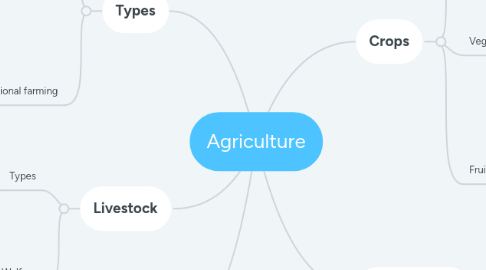
1. Types
1.1. Organic farming
1.1.1. Principles
1.1.1.1. Crop rotation
1.1.1.2. Green manure
1.1.1.3. Biological pest control
1.1.2. Benefits
1.1.2.1. Reduction in pesticide usage
1.1.2.2. Better soil health
1.2. Conventional farming
1.2.1. Methods
1.2.1.1. Monocropping
1.2.1.2. Heavy machinery usage
1.2.2. Environmental Impacts
1.2.2.1. Soil degradation
1.2.2.2. Increased pesticide usage
2. Livestock
2.1. Types
2.1.1. Cows
2.1.1.1. Dairy
2.1.1.2. Beef
2.1.2. Poultry
2.1.2.1. Chicken
2.1.2.2. Ducks
2.2. Animal Welfare
2.2.1. Free-range farming
2.2.2. Factory farming
3. Sustainability Issues
3.1. Intensive farming impacts
3.2. Soil erosion and degradation
3.3. Water usage and waste.
4. Crops
4.1. Cereal Crops
4.1.1. Rice
4.1.1.1. Paddy
4.1.1.2. Upland
4.1.2. Wheat
4.1.2.1. Hard
4.1.2.2. Soft
4.2. Vegetable Crops
4.2.1. Root vegetables
4.2.1.1. Onions
4.2.1.2. Potatoes
4.2.2. Leafy greens
4.2.2.1. Spinach
4.2.2.2. Lettuce
4.3. Fruit Crops
4.3.1. Berries
4.3.1.1. Blueberries
4.3.1.2. Strawberries
4.3.2. Citrus fruits
4.3.2.1. Oranges
4.3.2.2. Lemons
5. Technologies
5.1. Precision Agriculture
5.1.1. Yield monitors
5.1.2. Variable rate equipment
5.1.3. GPS agriculture
5.2. Drones
5.2.1. Benefits
5.2.1.1. High resolution imagery
5.2.1.2. Efficient crop monitoring
5.3. Autonomous tractors
5.3.1. Efficiency in farming
5.3.2. Reduced labor costs
